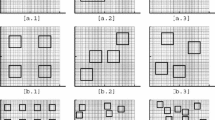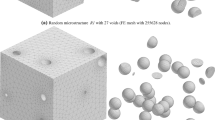Abstract
Fracture strains are predicted for ductile materials undergoing void growth and coalescence. The calculation scheme is based on Gurson–Tvergaard yield function and its associated flow rule. Fracture condition is identified by vanishing stress-carrying capacity of the material. The plastic flow parameters are all determined from experimental evidences for a variety of alloys. Comparison among predicted fracture strains and experimental ones is given for a wide range of conventional and superplastic materials as well as powder compacts. Finally an approximate fracture criterion is proposed.
Similar content being viewed by others
References
Rice, J.R. and Tracey, D.M. (1969). On the ductile enlargement of voids in triaxial stress fields. Journal of Mechanics and Physics of Solids 17, 201–217.
McClintock, F.A. (1968). A criterion for ductile fracture by the growth of holes. Journal of Applied Mechanics, ASME, 363–371.
Gurson, A.L. (1977). Continuum theory of ductile rupture by void nucleation and growth: part I-Yield criteria and flow rules for porous ductile materials. Journal of Engineering Materials Technology ASME 99, 2.
Le Roy, G., Embury, J.D., Edward, G. and Ashby, M.F. (1981).Model of ductile fracture based on nucleation and growth of voids. Acta Metallurgica 29, 1509–1522.
Saje, M., Pan, J. and Needleman, A. (1982). Void nucleation effects on shear localization in porous plastic solids. International Journal of Fracture 19, 163–182.
Tvergaard, V. (1982). Influence of void nucleation on ductile shear fracture at a free surface. Journal of Mechanics and Physics of Solids 30 (6), 399–425.
Needleman, A. and Tvergaard, V. (1984). An analysis of ductile rupture in notched bars. Journal of Mechanics and Physics of Solids 32(6), 461–490.
Becker, R., Neeldeman, A., Richmond, O. and Tvergaard, V. (1988). Void growth and failure in notched bars. Journal of Mechancis and Physics of Solids 36(3), 2317–351.
Rogers, H.C. (1960). Tensile fracture of ductile metals. Transactions of Metallurgical Society, AIME 218, 498–506.
Tvergaard, V. (1981). Influence of voids on shear band instabilibties under plane strain conditions. International Journal of Fracture 17, 389–407.
Tvergaard, V. (1982). On localization in ductile materials containing spherical voids. International Journal of Fracture 18, 237.
Bridgman, P.W. (1952). Studies in Large Plastic Flow and Fracture, McGraw-Hill, New York.
Tvergaard, V. and Needleman, A. (1984) Analysis of the cup-cone fracture in a round tensile bar. Acta Metallurgica 32(1), 157–169.
Hancock, J.W. and Brown, D.K. (1983). On the role of strain and stress state in ductile failure. Journal of Mechanics of Physics of Solids 31(1), 1–24.
Thomson, R.D. and Hancock, J.W. (1984). Ductile failure by void nucleation, growth and coalescence. International Journal of Fracture 26, 99–112.
Parmar, A. and Mellor, P.B. (1980). Growth of voids in biaxial stress fields. International Journal of Mechancal Science 22 133–150.
Kim, K.H. and Kim, D.W. (1983). The effect of void growth on the limit strain of steel sheets. International Journal of Mechancal Science 25, 293–300.
Date, P.P. and Padmanabham, K.A. (1992). On the prediction of the forming limit diagram of sheet metals. International Journal of Mechanical Science 34(5), 363–374.
Ragab, A.R. and Saleh, CH.A. (1999). On the prediction of the forming limit diagram of sheet metals. International Journal of Plasticity 15, 1041–1065.
Bampton, C.C. and Raj, R. (1982). Influence of hydrostatic pressure and multiaxial straining on cavitation in superplastic aluminum alloy. Acta Metallurgica 30, 2043–2035.
Zaki, M. and Suery, M. (1991). Transition cavity growth analysis of superplastic α / β brass. Current Advances in Mechanical Design & Production, Proceedings 5th Cairo Univeristy MDP Conference 467–477.
Pilling, J. and Ridely, N. (1986). Effect of hydrostatic pressure on cavitation in superplastic aluminum alloys. Acta Metallurgica 34, 669–679.
Spitzig, W.A., Smelser, R.E. and Richmond, O. (1988). The evolution of damage and fracture in iron compacts with various initial porosities. Acta Metallurgica 36(5), 1201–1211.
da Silva, M.G. and Ramesh, K.T. (1997). The rate-dependent determinations of Porous pure iron. International Journal of Plasticity 13(6, 7), 587–610.
Abbas, A.T. (1985). Assessment of plastic deformation and limit strains for sheet metals in biaxial stretching, M. Sc. Thesis, Cairo University, Cairo.
Tracey, D.M. (1971). Strain-hardening and interaction effects on the growth of voids in ductile fracture. Engineering Fracture Mechanics 3, 301–315.
Puttick, K.E. (1959). Ductile fracture in metals. Philosophical Magazine 4, 964–969.
Norris D.M., Moran, J.B., Scudder, J.K. and Quinonse, D.F. (1978). A computer simulation of the tension test. Journal of the Mechanics and Physics of Solids 26, 1–9.
Needleman, A. (1972). A numerical study of necking in circular cylindrical bars. Journal of the Mechanics and Physics of Solids 20, 111–127.
French, I.E. and Weirich, P.F. (1975). The influence of hydrostatic pressure on the tensile deformation and fracture of copper. Metallurgical Transactions 6A, 785–795.
Tegart, W.J.M. (1966). Elements of Mechanical Metallurgy, McMillan, New York, 22.
Bourcier, R.J., Smelser, R.E., Richmond, O. and Koss, D.A. (1984). The nucleation of cavities by plastic deformation. International Journal of Fracture 24, 289–297.
Fisher, J.R. (1980). Void nucleation in spherodized steels during tensile deformation, Ph. D. thesis, Brown University.
Goods, S.H. and Brown, L.M. (1979). The effects of second phases on the mechanical properties of alloys. Acta Metallurgica 27, 1.
Edelson, B.I. and Baldwin, W.M.Jr (1962). The effect of second phases on the mechanical properties of alloys. Transactions Quarterly of the American Society of Metals 55, 230–250.
Picking, F.B. (1978). Physical metallurgy and design of steels. Applied Science Publishers, 51.
Golaganu, M. and Leblond, J.B. (1993). Approximate models for ductile metals containing non-spherical voids-case of axisymmetric polate ellipsoidal cavities. Journal of the Mechanics and Physics of Solids 41(11), 1723–1754.
Andresson, H. (1977). Analysis of a model for void growth and coalescence ahead of moving crack tip. Journal of the Mechanics and Physics of Solids 25, 217.
Buorcier, R.J., Koss, D.A., Smelser, R.E. and Richmond, O. (1996). The influence of porosity on the deformation and fracture of alloys. Acta Metallurgica 34(12), 243–2453.
Livesey, D.W. and Ridely, N. (1978). Superplastic deformation; cavitation and fracture of microduplex Cu-Ni-Zn alloys. Metallurgical Transactions 9A, 519–526.
Author information
Authors and Affiliations
Rights and permissions
About this article
Cite this article
Ragab, A. Prediction of ductile fracture in axisymmetric tension by void coalescence. International Journal of Fracture 105, 391–409 (2000). https://doi.org/10.1023/A:1007640111739
Issue Date:
DOI: https://doi.org/10.1023/A:1007640111739




